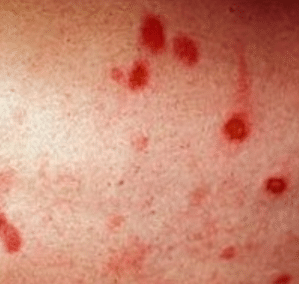

A topical anesthetic may be applied prior to the procedure to help reduce discomfort. This minimally invasive cosmetic procedure uses small needles to prick the skin. You may experience some temporary redness and tightness after the procedure. Microdermabrasion causes little to no pain. This is followed by suction to remove dead skin. During this procedure, an applicator with an abrasive tip gently removes the outermost layer of your skin.

A liquid nitrogen solution or nitrous oxide is used to freeze off sunspots. Cryotherapy is a fairly quick, in-office procedure that is effective in treating sunspots and other skin lesions. Pain medication and cold compresses can help with discomfort as you heal. Chemical peels may cause a burning sensation that lasts a few minutes and can be painful. An acid solution applied to sunspots causes the skin to eventually peel away so that new skin can grow. In laser skin resurfacing, a wand-like device delivers beams of light to the layers of your skin until the sunspots are no longer visible, allowing new skin to grow in its place. You may need multiple sessions to achieve your desired result. IPL removes sunspots by heating and destroying melanin with pulses of light energy. Creams containing hydroxy acid, glycolic acid, kojic acid, or deoxyarbutin are the most effective. There are several creams available over-the-counter that can be applied at home to fade sunspots. Evidence suggests that dietary vitamin E and topical vitamin E oil help protect your skin against sun damage and lighten sunspots. Applying vitamin C topically is also an effective way to lighten various dark spots caused by the sun. The antioxidant properties of vitamin C offer several benefits related to the sun, including a protective effect against UVA and UVB rays. Research has shown it to be effective in lightening melasma. Milk, sour milk, and buttermilk contain lactic acid that may help lighten skin pigmentation, including sunspots. Licorice extract is a common ingredient in many commercially available creams for sunspots because it’s been shown to lighten skin discoloration caused by sun damage.

Green tea extract has been found to have a depigmenting effect, according to a 2013 review in the Journal of Cutaneous and Aesthetic Surgery. A 2011 study on guinea pig skin found that applying black tea water to tanned spots twice a day for four weeks had a skin-lightening effect. The acetic acid in apple cider vinegar may help lighten sunspots when applied regularly, according to a 2009 review in the International Journal of Molecular Sciences. Aloe vera contains active compounds, including aloin and aloesin, which have both been found to effectively lighten hyperpigmentation, including sunspots. I'm new to this site, I'm assuming I'll get an alert or something if anyone else posts.I hope. especially not in our world of skyrocketing chronic illness and constant exposure to new and existing toxins and biological disruption. Something is causing our capillaries to weaken and burst, SOMETHING is the cause, it's not just "normal," and until we know for sure we can't just assume it's inconsequential or benign. I'm assuming something environmental or in our food supply (cough, glyphosate) maybe bc my husband now has them as well. It's not age (which I initially thought) as I've come across many younger people experiencing the same. I've tried finding answers, seems they're very common but I want to know WHAT it is that's causing them. What I've noticed is the old ones will typically move to the surface and get exfoliated away but there's always more, newer ones popping up. At times there will be like an explosion. Started on my arms a few yrs back and has slowly spread down my entire arms, torso and now a few spots have popped up on my thighs. Just wanted to hop on here bc I have the same issue.


 0 kommentar(er)
0 kommentar(er)
